Xingyi Quan, as a derivative of Xinyi Quan (Dai Family 戴氏心意拳) and Xinyi Liuhe Quan 心意六合拳, represents the Form/Shape and Intention Boxing. The essence of Xingyi Quan is based on five phases/elements and twelve animals however it is the intention of these which is paramount.
It’s creation or development is attributed to Li Luoneng in the 1800’s Xingyiquan became well known throughout Shanxi and Hebei province. Li Luoneng was a native of Shen county, Hebei and had studied local styles there (e.g. Bafanquan) prior to finding his teacher in Shanxi under Dai Erlu (Da Wenxiong), studying for over 10 years. He was later hired by Meng Furu as a security guard for the Meng family (one of the wealthiest in Qi county), later also functioned as Biaoshi (Logistics security guard). Meng Furu was head of the family. In 1856, at the recommendation of Meng Furu 孟綒如, Che Yizhai (车毅斋, 1833 – 1915) was formally accepted as Li’s disciple. Together, the three developed Xingyi Quan and then passed the style onto students in Shanxi and at Li Luoneng’s home (Shen county, Hebei) where he travelled to for the remainder of his life in Hebei.
Origins of Xingyi Quan
Li Luoneng’ began the teaching of his version of Xinyiquan 心意拳, as Xingyiquan 形意拳 at Taigu County in the 1856 until 1871. In addition to Meng Furu and Che Yizhai, Song Shirong (宋世荣, 1849 – 1927), Song Shide (宋世德, 1857 – 1921), Li Guangheng (李廣亨, 1859 – 1934) are some of his students during this period. This earlier version of Li’s Xingyiquan is classified as Shanxi Xingyiquan in modern days Xingyiquan circle. Li Luoneng (李洛能 1807-1888) was born in Shenzhou City, Hebei Province. Li passed away in 1890 at the age of 81 years old. He had studied Bafanquan and Tongbeiquan since young and was highly skilled. Li Luoneng resided to Taigu County of Shanxi Province for business purposes at the age of 37 in 1845 and he began to learned Dai family version of Xinyiquan during the same year. Li established himself as a great martial artist in Shanxi, which also earned him the nickname of Divine-Fist-Li (神拳李), within 10 years of after he started in Xinyi.
Li Luoneng, at 63 years old, returned to his hometown, Shenzhou City, in 1871. Li continued to spread the art of Xingyiquan at his hometown in his later years. His son Li Taihe (李太和), disciples Guo Yunshen (郭云深, 1820 – 1901), Li Qilan (刘奇兰, 1819 – 1889), Liu Xiaolan (刘晓兰, 1819-1909), He Yunheng (贺运恒) are the students of this period. The Xingyiquan of this period is usually referred as Hebei Xingyiquan.
Dissemination of Xingyi Quan
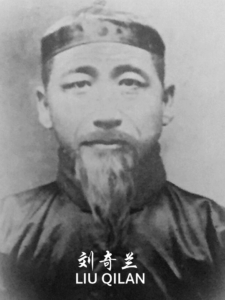
2. Liu Qilan (刘奇兰, 1819 – 1889) was one of the top students of Li Luoneng (李洛能). Liu together with Guo Yunshen (郭云深, 1820 – 1901), Song Shirong (宋世荣, 1849 – 1927) and Che Yizhai (车毅斋, 1833 – 1915) are known as the top four disciples of Li Luoneng. Liu Qilan was born in a scholarly family at Shen County, Hebei Province. Liu Qilan had studied martial arts since his youth, specifically Jingangquan and later learned Xingyiquan from Li Luoneng when Li was invited to teach in Liu family. Liu Qilan was not only skilled with combative techniques but also, with his scholar background, well known with his Xingyiquan theories and concepts; martial artists who have visited Liu were convinced with Liu’s martial abilities and theories. Liu Qilan was known for his shenfa (body method), was praised as ‘Long Xing Sou Gu’ (dragon shape searching for bones). The bulk of what is representative of Hebei Xingyi boxing today was developed by Liu Qilan, and spread through his descendants. Liu Qilan is known as the principal contributor of Xingyiquan as Liu lineage is the most influential and most widely spread among all other Xingyiquan lineages. Li Cunyi (李存义, 1847 – 1921), Zhang Zhankui (张占魁, 1865 – 1938), Geng Jishan (耿继善), Zhou Mingtai (周明泰), Wang Fuyuan (王福元) and Liu Dianchen (刘殿琛 (刘文华), second son of Liu Qilan) were some of Liu’s most well known successors.
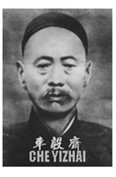
2. Che Yizhai (车毅斋1833-1914), also known as Che Yonghong was from Taigu, Shanxi Province. He was from a poor family and started martial arts training in 1848 with Wu Hongpu and Wang Changdong. In 1856, he became a student of Li Luoneng and became exceptionally skillful. After Li Luoneng returned to his old hometown in Hebei, Che remained as his most well known disciple in Shanxi and had extended his studies whilst researching the methods of Xingyiquan to systematically refine its contents. Although well known for his skills, even receiving a ceremonial title by the Qing government, Che Yizhai was very selective in passing on his skills accepting less than 20 disciples in his life.
Many of the Hebei practitioners would travel to Shanxi and receive his advice and guidance for their Xingyiquan practice, including Li Cunyi, Guo Yunshen, Li Taihe (Li Luoneng’s son), Liu Wenhua (Liu Qilan’s son), and Sun Lutang, among the most well-known. The two man sets of Xingyiquan are mostly attributable to Che Yizhai’s efforts, along with those of his disciples Li Fuzhen (1855–1930) and Bu Xuekuan (1876–1971). Che was known as a formidable expert, having gained much experience during his Security Logistics escort work (Taigu was well known for this during the time) with the Qiao family.
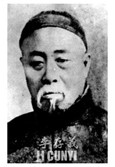
3. Li Cunyi (李存义, 1847–1927) was born in Shen County, Hebei Province, in 1847. Li studied Xingyiquan under Liu Qilan (刘奇兰, 1819–1889) at 20 years old; he later became friends with Cheng Tinghua (程庭华, 1848–1900) and also studied Baguazhang under Cheng’s teacher, Dong Haichuan (董海川, 1797–1882). In actuality, it was Cheng who passed most of the Baguazhang skills to Li. Between 1894 and 1900, Li held many positions, such as instructor for the Qing army, Liu Kunyi (1830–1902) in 1890, squad leader for security groups in Zhejiang and Jiangxi, as well as opening his own Wantong Biaoju (Logistics Security Escort Service). Li Cunyi joined the “Righteous Harmony Society” at the age of 50 in 1900. Li used to hold a sabre against the army of the Eight-Nation Alliance during the Boxer Rebellion, and the nickname “Single Sabre” Li has become famous. To retreat while fighting Li Cunyi was a big mistake; as soon as you tried to retreat, he would be upon you and knock you down.
After the Boxer rebellion period, Li Cunyi hid from authorities at his martial uncle’s homes in Taigu, Shanxi, with Che Yizhai, who taught him all of his Xingyiquan, and also with his other uncle, Song Shirong, from whom he learned further internal cultivation techniques. This placed Li Cunyi in a unique position to encompass the complete body of Xingyiquan, integrating those of both Shanxi and Hebei practices. Li Cunyi had co-founded the “Chinese Warrior Association” in Tianjin City in 1911, which spread the skill of Xingyiquan. This caused Tianjin to become one of the headquarters of Hebei Xingyiquan. Li Cunyi later taught his arts at Shanghai Jingwu Tiyuhui (Chin Woo Athletic Association) under the invitation of the association. Li Cunyi retired to his hometown and taught the skills of Xingyiquan in his later years. Li passed away at the age of 74 in 1921. Li Cunyi’s had a great many students, but those most well known include Shang Yunxiang (1846–1937), Li Xingjie (1879–1948), Fu Jianqiu (1885–1956), and Chu Guiting (1892–1977).
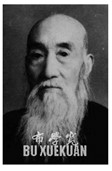
3. Bu Xuekuan (1876–1971) was born in Qi county, Shanxi Province and later moved to Taihu County. Although he came from a family of farmers, they managed to send him to school
and Bu was later apprenticed to a win jar seller and later in a grain store. He started martial arts in 1891 and later followed Che Yizhai in 1900 to study Xingyiquan. Due to his precise techniques and postures, He became one Che’s key disciples and made many contributions to Xingyiquan throughout his long and influential lifetime.
Bu Xuekuan is credited with many developments of Xingyiquan, including further combat sets, Health preservation methods and new techniques. In his early days, he had many students, having taught since 1913, He also helped expand Xingyi’s influence by working as the director of physical education for Taihu in 1917 and later as the martial arts instructor at a college in 1930. He was also later a commissioner in local government and as chairman of the Wushu association. In his later years, many Xingyiquan experts sought his advice and further teachings, given his vast knowledge and experiences.
Some of the most well-known students included Sun Deyi, Yan Yewu and Zhang Yongyi, whilst some of his students also took Xingyiquan to Central and South America, such as Wu Chaoxiang (Brasil) and Li Ying’ang (Guatemala). Later, during the socio-political changes, Bu Xuekuan became involved government organisations and held numerous posts across martial arts institutes and associations both locally and nationally. Bu Xuekuan was one of the most revered Xingyiquan masters of his generation; he lived to a ripe age of 96.
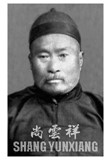
4. Shang Yunxiang (尚云祥, 1864–1937) was born in Laoling, Shandong Province, in 1864. When he was young, he studied Gongli Quan with Ma Dayi, then followed Li Cunyi, becoming one of his best students. Shang also received instructions from Guo Yunshen and Cheng Tinghua. It is said that in the beginning, Li Cunyi did not favour Shang Yunxiang, as he was short and thin, but was persuaded by his colleague, Zhou Mingtai (also a disciple of Liu Qilan), to accept Shang. As a result of the little that Shang was taught, he practiced diligently and developed great power through his Beng Quan (his fame earned him the nickname “Buddha with Iron Feet”). Once, when there was a conflict, Li Cunyi observed the great diligence Shang showed and decided to teach him wholeheartedly.
His martial uncle, the original half-step Beng Quan expert, Guo Yunshen, also took an interest and taught Shang Yunxiang as well. Shang worked as a Security Logistics Bureau chief and also as a martial arts teacher throughout his life. Shang was a very practical teacher, demanding high standards from his students, which resulted in many injuries during hands-on combat exchanges. It is important with Shang’s method to emphasise the actual combat within training; while relatively short, he was a powerful, outspoken, quick-tempered man who would get into fights often as a result. Shang was a great expert and through his experiences, he deeply understood the essence of Xingyiquan. He researched, just like his teacher Li Cunyi, other variations of Xingyiquan and developed a very systematic approach.
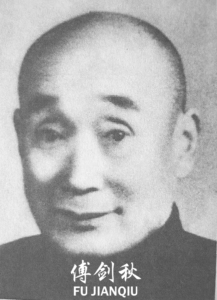
4. Fu Jianqiu (傅剑秋, 1880 – 1956), also known as Fu Xianong, was born in Cao Village, Ninhe, Tianjin (Zhili). He commenced martial arts from a young age, following Shang Huichuan (尚汇川) and later M Shen Wanlin (申万林) a practitioner of many styles, including Tongbei, Pigua, and Xingyiquan. In 1909, Fu became a disciple under Li Cunyi and Liu Fengchun, studying the internal martial arts of Xingyiquan, Baguazhang and Taijiquan.
In 1919, he had a number of fights against Japanese, Russian and Chinese opponents in the Dongbei region, receiving recognition from General Zhang Zhuolin of the Fengtian Clique. After this, he was offered a position as martial arts instructor for the Northeast Army and as one of Zhang’s bodyguards. M Fu later returned to his hometown in 1922, where he opened a national martial arts academy.
In 1927, Wudang Sword expert GM Li Jinglin invited M Fu to visit Wudang Mountain. Together with his disciple Pei Xirong, Fu Jianqiu met and studied under the Daoist Priest Xu Benshan (head of the Quanzhen Dragon Gate School of Daoism). M Fu became a 16th-generation disciple of the Daoist lineage, named Fu Heshan. In 1936, Fu moved to Suzhou with his son Fu Shaoxia and was a coach for a village military. He also travelled to Shanghai, Hangzhou, and Wuxi, teaching in different schools and places.
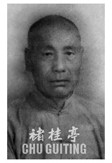
4. Chu Guiting (褚桂亭, 1892-1977) was born in Renqiu County, Hebei Province, in 1890. Chu, in his youth (7-8 years old), commenced the study of martial arts with local masters Jiang Yuhe (Xingyiquan), Yu Bingzhong (Drunken Eight Immortals Boxing), and Chen Delu (Baguazhang). In 1912, he became the disciple of Li Cunyi and an expert in Xingyiquan. Chu dedicated his life to martial arts and studied Yang Style Taijiquan with Yang Chengfu and Yang Shaohou, Bagua with Liang Zhenpu, Wudang Sword with Li Jinglin, and also studied and exchanged with other experts such as Sun Lutang, Shang Yunxiang, Zhang Zhankui, Huang Bonian, and so on. In his twenties, he travelled around the country (Beijing, Tianjin, Liaoning, Wuhan, Nanchang, & Changsha) and sought out teachers to enhance his martial arts.
In 1928, the national full-combat competition was held in Nanjing, China. Hundreds of experts from across the country competed, and after several days, the fighting competitions were stopped because too many competitors became seriously injured, including two deaths. Upon stopping, the remaining 12 martial artists were regarded as champions, and Chu Guiting was one of them.
In the 1950’s, Chu Guiting lived in Shanghai and taught at local parks, government companies, and agencies across the city. He befriended many martial artists, including Wang Ziping, Lu Zhenduo, Cai Longyun, Fu Zhongwen, and Zhang Yu. He was highly respected throughout the martial community. Chu was known to accept many students, even from other styles, and has had a big influence on the spread of the internal styles in Shanghai. Chu Guiting is said to have taught thousands of students throughout his lifetime.
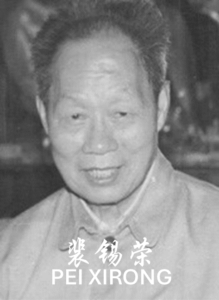
5. Pei Xirong (裴锡荣 1913–1999) was born in Raoyang, Hebei Province, in 1913. His father was a Chinese TCM physician, was a member of the Yihetuan, and practiced martial arts as well. His uncle, Qi Dalong, was a bodyguard in the Logistics Security Bureau, established by Li Cunyi.
Inspired, M. Pei studied local boxing with his uncle when he was young. When he grew up, he travelled around, like most martial artists did, to seek different styles and learn from different masters. GM Pei also continued the study and practice of Chinese medicine, which his family had practiced for four generations.
When he was just 16, in 1929, M. Pei Xirong went to the national gathering in Nanjing, where he met Fu Jianqiu. After that, he focused on studying martial arts with Fu Jianqiu (the disciple of renowned Xingyi Quan M. Li Cunyi). He was also introduced by Li Jinglin (famous for his Wudang sword skill, general, and director of several martial arts institutes), together with M. Fu Jianqiu to meet the head of Wudang Mountain, Xu Benshan, and became the official disciple of the 17th generation of Wudang Long Men. M. Li Jinglin recommended Pei study at the Nanjing Academy, which he did. Pei also worked in Zhengzhou as an editor, and during that time he learned Xinyi Liuhe from M. Bao Xianting.
M. Pei, given his medical, martial, and editorial skills, authored and/or edited a number of texts, including “Henan Authentic Xingyiquan,” “Bagua Sanshou 64 Sequences,” “Wudang Wugong,” “Bagua Eight Shapes Palms,” China Wudang Eyes Skills,” “Wudang Taijiquan, and Pan Shou.”. In Shanghai, he studied with Lu Songgao. M. Pei also studied baguazhang with Huang Bonian and Jiang Rongqiao. He also became a martial arts coach at Shanghai Fu Dan University. He founded the Shanghai Wudang Quan Fa Institute, the Qigong Study Institute, and the Shanghai Qigong Scientific Study Institute. In his late years, he focused on studying Wudang Daoist theory and how meditation and Nei Dan Gong (internal practice) enhance both the immune system and spiritual well-being. He promoted the idea that a martial artist should cultivate himself according to Daoist ideals, from aspects such as virtue, mind, character, thoughts, and behaviour.
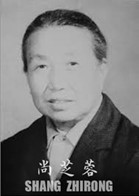
5. Shang Zhirong (尚芝蓉, 1923–2004) was born in Laoling, Shandong. Shang Zhirong was born into a family of martial artists. She started practicing at the age of 5 with her father, Shang Yun-Xiang. She was very talented and showed great potential during her practices. Her father was very pleased. Shang Yun-Xiang had two sons and three daughters; Zhi-Rong is the youngest. Unfortunately, his two sons and second daughter had died of illnesses. Shang Zhirong was a teacher for the Beijing Police Force for 8 years, the 1st Chairman of the China Shang Style Xing Yi Quan Association, and a consultant for the Xing Yi Quan Association in Shandong and Beijing. She had the honour of being a guest and referee in numerous international and domestic Xing Yi Quan competitions. In 1989, she co-authored “Xing Yi Quan and Weaponry” with her classmate.
Master Shang Zhi-Rong was listed in the “Wudang Wushu Dictionary” and “Civil Martial Artists.”. Many of her elders had also taught her and exchanged different skills. Shang Zhirong was able to pass on the Shang Style Xingyiquan to many students, including Zheng Yijun, Wang Chaoying, Li Wenjun, Huang Shihai, Fan Yongde, Li Shhua, Sun Changjiang, Li Xingqiang, Li Xingwei, Lu Taimin, Sun Dongchang, Xu Keyao, Meng Zhihong, Zhang Desheng, Song Hongguang, Song Lei, Li Wendong, Wang Xiuguang, Xu Zhanglian, and others. Her inheritor, however, became her son-in-law, M. Liu Junfeng, and the eldest daughter, Zhi-Xiang, did not learn martial arts.
Shang Yun-Xiang decided that Zhi-Rong would become his successor, and he taught her with great patience. Shang Zhi-Rong practiced with diligence, and after a decade of hard work, he had mastered all the skills of the Shang Style Xingyi Quan and weaponry. Shang Zhirong learned the treasured techniques of the “long pole,” “half-step Beng Quan,” and “internal breathing” passed on from Master Guo Yun-Shen to her father. She also learned all the secret training, exercises, and weaponry and was the most knowledgeable of all his students. While many had studied with her father, they often had incomplete elements. Other renowned Xingyiquan practitioners, such as Li Wenbin, who only studied for four years with GM Shang Yunxiang, sought Shang Zhirong to learn the spear, sabre, double sabres, and other materials from her father’s legacy.
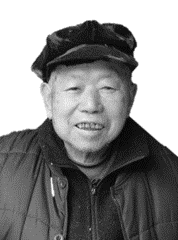
5. Yu Fengyi (余凤仪, 1925–2017) was born in Anhui to a martial family. His father led the family to move to Shanghai when M. Yu was very young. Although he had brothers, they did not take an interest in the martial arts. His father, seeing both his potential and passion, sent M. Yu to learn from renowned teachers in Shanghai, including wrestling and liuhequan with Tong Zhongyi and mizongquan with Lu Zhenduo. His father’s martial arts being hard and external, M. Yu later found an attraction to the internal arts; it was then that he studied under the guidance of M. Chu Guiting. During the cultural revolution period, M. Yu was sent south (near Hangzhou) for a number of years (M. Yu was a chemical engineer).
There, he was introduced to further Neigong methods by a Daoist, who had been displaced during the social unrest. Upon returning to Shanghai, he studied for a short while with M. Pei Xirong, who by then also emphasised internal cultivation with Daoist principles, before focusing on his own cultivation. M. Yu had a number of different students, many of whom focused on Qigong, or internal cultivation, and his grandson-in-law, whom inherited his lifetime legacy.
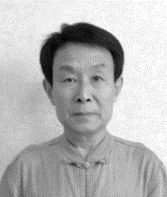
6. Liu Junfeng (刘俊峰), heir of the Shang’s Style Xing Yi Quan lineage, was born in LeLing County, Shandong Province in 1958. Master Liu had an interest in martial art at a very young age. He learned from Master Shang Zhi-Rong (Daughter of Shang Yun-Xiang, founder of Shang’s Style Xing Yi Quan, and teacher for Beijing Police for 8 years). He learned all the basic skills, such as fist and weapon forms, body conditioning, etc.
He specialised in Xing Yi Quan but is also well versed in Bagua, Baji (Qingyun near Laoling is known as the birth place of Wu Zhong, founder of bajiquan), wrestling, Sanda and so on. Master Shang Zhi-Rong appreciated Master Liu’s honest character and hard-working attitude.
M Shang Zhirong arranged for her daughter to marry Master Liu and Master Liu was the heir to the lineage of Shang Style Xing Yi Quan. Master Liu also learned from other martial uncles like Han Boyan, Li Wenbin, Li Zhendong, Zhang Bingren, etc. and had a thorough understanding of Shang Style Xing Yi Quan’s theory and application. Master Liu is the Chairman, Chief Secretary, and Executive Director of the China Shang Style Xing Yi Quan Association, Vice President of the China Shenzhou Li Laoneng Xing Yi Quan Association, Vice President of the Shandong Xing Yi Quan Association, Honorary Chairman of the Dezhou Wrestling and Judo Association, Principal of the Leling Xing Yi Quan Martial School, and Consultant and Coach of China Xing Yi Quan Association in Germany. Master Liu is not only highly skilled in the practical application, but he is also profound in the academic and theoretical aspect of Xing Yi Quan.
Xingyi Quan system
Xingyiquan has had a glorious history since its inception by Li Luoneng. Like generations before, Taiping Xingyiquan integrates different Xingyiquan lineages (Shanxi and Hebei), but is predominantly based on the Chu Guiting and Shang Yunxiang teachings of Li Cunyi’s Hebei Xingyiquan.
The basic practices require of sight, hands, waist, stance/step, hip, elbows, knees and shoulders to be coordinated, flexible and strengthened.
Liuhe Qiankun Zhuang (Six Harmonies Universal Post Standing)
The foundation of Xingyiquan includes the practice of standing for it is in this stage that concepts of alignment and repair to enable circulation can be encountered. In addition to alignment or structure, the practice also enhances the preparation for intention and the improvement of breathing and associated energic balance.
- Qiankun Zhuang | 乾坤桩
- Hunyuan Zhuang | 混元桩
- Liuhe Zhuang | 六合桩 (三体桩)
Bufa (foundation stepping)
In Taiping Xingyiquan, one of the most emphasised foundation practice is stepping. Although Xingyiquan to the novice is conceptually just linear, there is great importance in how the lines are best applied. For this reason, stepping is the ultimate foundation. Many of these stepping methods are seldom seen today but for traditional practice, especially in combat, they are crucial and therefore very important for Taiping Xingyiquan. These are typically practiced on their own and then together with the Yingzhuo (鹰捉) before they are further developed through the five-phase fists.
- Ding Bu | 定步
- Gen Bu | 跟步
- Shun Bu | 顺步
- Ao Bu | 拗步
- Huo Bu | 活步
- Tang Bu | 趟步(称槐虫步)
Ying Zhuo (Eagle Siezing)
The practice of Yingzhuo (Eagle Siezing), often called Mu Quan (Mother Fist), is essential. There are precise requirements, which are then followed by a number of variations. Yingzhuo emphasises the important points of rise and fall (Qi Luo), drill and overturn (Zuan Fan), and contract and expand (Shu Zhan), as well as encompassing the essence of the three fists: wrapping, drilling and cutting (Guo, Zuan, and Jian). It is often thought that the variations and practical combat applications are infinite and thus a great deal of practices are possible.
Wuxing Quan (Five Phases Boxing)
The five phases fists include Chopping (Pi 劈), Zhuan (Drilling 钻), Crushing (Beng 崩), Pao (Explode 炮) and Heng (横), which are all conducted with the fist and are correlated to the five phases theory of traditional chinese Daoist cosmology. These are Metal, Water, Wood, Fire and Earth. These are the most important foundation in Xingyiquan, whilst each of the methods apply a number of vectors and thus power, they also contain the basis of contraction and expansion, which means to the three powers (Ming, An, and Hua), the various footwork and the manifestations of the basic methods. Practice is with the various stepping variations, including advancing or retreating and also shaking body, turning body and guiding hand.
- Five Elements individual practice | 五行拳(劈、崩、钻、炮、横)[金、木、水、火、土]
- Five Elements of Mutual Growth (Lianhuan, Continuous) First | 五行相生
- Lianhuan (Continuous) | 五行连环拳
Shierxing Quan (Twelve Shapes Boxing)
The 12 animals are the heart of Xingyiquan, where the five phases are said to be the intention foundation (Yi), and the 12 animals represent the structure or shape (Xing). There are twelve animals represented, such as Dragon, Tiger, Monkey, Horse, Chicken, Yao Sparrowhawk, Swallow, Snake, Alligator, Ostrich, Eagle & Bear.
- 12 shapes individual practice | 十二形拳 (龙、虎、猴、马、鸡、鹞、燕、蛇、鼍、骀、鹰、熊)
- 12 shapes combined into one | 十二形合一
Zonghe Quan (Combined Sets)
To exemplify the ability to combine and evolve the principles. There are combinations of the foundation five elements and twelve animals, as well as techniques introduced by teachers, including from outside styles (e.g. Chuojiao, Bajiquan). Bashi Quan combines four elements and four animals into a short, compact set. Si Ba Chui is a classical set. Yuanyang Jiao (also known as 18 kicks of Xingyiquan) is a set introduced by Li Fuzhen, who created after learning from Chuojiao expert Wei Changyi. There are variants to these core as well (e.g. Jingang Bashi). The three strike sets (Zhashi, Shier Hong & Shier Lian Chui) are practical combination methods that emphasise combat applicability. Zhashichui (mixed strikes) is said to have been developed by Che Yizhai on the basis of the Dai Family Zhashi (which itself was based on Tanglang Quan), with many methods within.
| 八式拳 Ba Shi Quan 四把捶 Si Ba Chui 六合拳 Liuhe Quan | 十二洪捶 Hong Chui 十二连捶 Lian Chui 十二形捶 Xing Chui | 出入洞 Chu Ru Dong 鸳鸯脚 Yuanyang Jiao 杂式锤 Zha Shi Chui |
Bazi Gong (Eight Character Skills)
The Bazi Gong are an advanced part of the Xingyiquan curriculum. It is often said the Five phases develop power, the twelve shapes develop skills, and the eight characters develop fighting abilities. The Bazi techniques are direct and applicable. Through the ages, the Eight Character Skills have been regarded as treasures by martial artists. Ordinarily, it is not trained in public and it is not lightly taught to people.
In the practice, each character (Zi)—Zhan (展 Chopping), Jie (截 Intercepting), Guo (裹 Wrapping)、, Kua (跨 Carrying), Tiao (挑 Lifting), Ding (顶 Erecting), Yun (云 Cloud), and Ling (领 Leading)—is practiced individually; these are known collectively as Bazigong (Eight Character Skills), and then there is a combination set (Eight Character Linked Set).
- 八字功 (Ba Zi Gong )
- 八字连环拳 (Ba Zi Lian Huan Quan)
Sanpan Shou (three-level fists)
These represent further methods practice, integrating principles from all the prior skills, including the five phases, twelve animals, and eight characters, with power generation (Ming, An, and Hua) at its core. These emphasise three phases: powerfully coordinated skill in the Ying Ba Shou (Hard Eight Hands), to gentler interchange skills in Ruan Ba Shou (Soft Eight Hands), and the integrated phase in Hua Ba Shou (Transformational Eight Hands, sometimes called Yinyang Shou). These include aspects of: Chan 缠、Ding 顶、Kao 靠、ye 掖、guang 广、li 立、gun 滚、zuan 钻.
- Ying Ba Shou | 硬八手 (上)
- Ruan Ba Shou | 软八手(中)
- Hua Ba Shou | 化八手 (下)
Combat 2 man sets
| Jiu Quan | 九拳 Jiu Lianhuan | 九连环 Pi Wuxing | 劈五行 Pi Chui | 劈捶 Wudong Chui | 五动捶 | Wuhua Pao | 五花炮 Wuxing Pao | 五行炮 Anshen Pao | 挨身炮 Lianhuan Shou | 连环手 | Wucai Liuchuii | 五踩六捶 Shier Lianchui | 十二连捶 Shiliu Ba | 十六把 Zhizuan Chui | 址钻捶 Jiu Tao Huan | 九套环 |
In Xingyiquan there are basics for each weapon following the Wu Xing (five phases 五行棍,刀,剑,枪,大刀等), then Wuxing Lianhuan (five phases linked sets, 五行连环棍,刀,剑,枪,大刀等) sets for each of the four main weapons as a foundation, followed by Liuhe (six harmonies, 六合棍,刀,剑,枪) sets at intermediate levels. M. Shang emphasised that weapons follow the fists so there can be equivalent weapons sets aligned to the fist sets. However, there are also specialist methods as well, with the emphasis on the Liuhe (Six Harmonies) long spear as the most important as it helps train power and spear methods simultaneously.
| Sancai (3 treasures) sword | 三才剑 Liuhe Sanshiliu Sword | 六合三十六剑 Five tigers, Sabre 形意五虎刀 | Continuous Double Sabre | 连环双刀 Jiuzhou (9 provinces) staff | 九州棍 | Xingyi Shisan Qiang | 形意十三抢 Liuhe (Six Harmonies) great spear | 六合大枪 |
